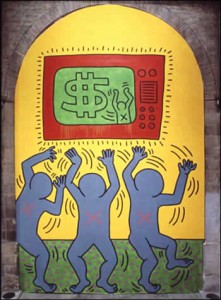Reposted from: http://rsfsocialfinance.org
From Intersection To Crossroads: An Invitation to Inquiry into Money and Spirit
March 16, 2009
By John Bloom
No productive inquiry begins without disclosing assumptions, even the assumptions behind the assumptions, for the sake of transparency. If you found this blog via the RSF website, you probably noticed three questions on the homepage: Can money nurture your spirit? Can money heal the planet? Are you inspired to learn more? These are not casual questions. They are meant to invite dialogue with us and across a growing community of investors, donors, and borrowers who know that change is needed in how we work with money and in the financial system. What the new ways will look like, how they will evolve is a matter of co-creating them with sensitivity to real social needs, spiritual and ecological integrity, and the full dimensions of interdependence in our economic life. Certainly, our work here at RSF Social Finance is directed toward evolving answers to these questions.
We would not ask the question about money nurturing your spirit if we didn’t have 25 years of experiencing that it can. But, as one who has led many conversations on money, this positive view is not commonplace at the outset, and changing that perception is not simple. Instead, the inner personal world of money is opaque, and attempts to explore it feel more like trespassing than discovery of what is already owned. So the question is a challenge to explore the intersection of money and spirit as it is situated in your life. How, for example, do your deepest values and beliefs currently play out in your financial practices? Withhold judgment. Instead consider each transaction a moment of intersection, a moment to engage in reflection and inquiry. When the inquiry surfaces insights, the intersection will likely become more of a crossroads connecting to your broader map of experience. I am not suggesting that this is easy, but it is a place to begin transforming how you connect your spirit with your financial practices. One of our assumptions is that systemic transformation begins with personal transformation. So sharing your experiences at this crossroad will further nurture your spirit and help others with whom you work, trade, invest, or give.
Can money heal the planet? This second question is not as much about nurture as it is about the nature of nature. There are numerous assumptions within the framework of the question itself—some of them controversial. The planet includes all the physical or material aspects of nature, all the living beings that inhabit it, and then the larger cosmic or spiritual forces at work on and in it including human nature. So the challenge here is to develop an ecological imagination of interdependent systems. Money is an invention of human nature. Thus, in its circulation and other uses, it is inseparable from any of the other systems. Given this set of assumptions, our attitudes toward nature and our economic practices with natural resources are likely to be reflected in our financial practices. And, how we work with money, the energy and intention that flow through it will also influence and be expressed in how we treat nature as the source of economic activity. If one looks at our current state of affairs, should it come as a surprise that our extractive and non-restorative approach to natural resources is mirrored in our extractive and non-restorative financial drive for wealth accumulation? This observation is in some ways an oversimplification, but to make a point—that by working to heal the planet we can work with money in a healthier way, and also heal ourselves. As money follows the paths of our intentions, it will also be a partner in this powerful reciprocal relationship. I believe this is a living picture of interdependence.
I am sure there are many more perspectives on the questions of money, spirit and the planet. This is why we ask the question: Are you inspired to learn more? We certainly are, and hope you will join us in using conversation and dialogue as powerful tools for transformation and building community.
More on the Intersection of Money and Spirit
April 20, 2010
To read an earlier post that John wrote on the intersection of money and spirit, click here.
By John Bloom
As I write about the intersection of money and spirit, I realize I have been conditioned throughout my biography to consider them as discrete – and it is thus a challenge and transformative indiscretion to speak of a connection between the two. I do not think it would be fair to characterize money and spirit as being in opposition, as they often are. Such a polarity would dishonor the genius that devised money in the first place. So, let me make a bold statement: Money is an inspired invention to account for and store value in order to free up enterprising people to serve each other and communities in the realm of economics.
As a device, money circulates so that individuals (and organizations) have the resources to bring their particular capacities into the economy for the overall well-being of the community (however one might want to define that). One result is that people’s material needs are met, although that only encompasses the tangible part of an economy. One might say the spirit of money lives on, not in the objects that denote it such as paper bills and coins, but rather in how it passes hands, with what understanding and agreements, and through what transactional rituals. For example, if I look at my economic self, I imagine that my personal inspiration – that which motivates me – adds value to the circulation of money, because of my intention of service. It is also an essential part of my process to be as sure as possible that the other party’s needs are met. This requires an additional reflective, evaluative, loop-closing step in the transaction process – all of which might come under the descriptive heading of reciprocity. This transactional process goes beyond any document commemorating the agreement to a living recognition of those involved in the transaction and the value of the relationship. In other words, through our transactions we become part of each other’s stories. This is a radically different construction of a transaction than we are conditioned to understand.
The power of money to subjugate rather than free us was at the center of Keith Haring’s monumental mural installation entitled The 10 Commandments (1985). Haring’s genius was that he communicated so much through limited graphic means. He did not set out to illustrate the biblical commandments literally. Instead, he based the paintings on his recollected experience of them as they play out in contemporary society. For example, he rather pointedly illustrated the degree to which money had become a false idol. We see the hand from above (a reuse of the early medieval trope of referencing God through the hand) tantalizing the hands below with a $0 bill. The hands from below are trembling, clamoring for the money though it has no value. The work is a direct commentary on how money has become a thing and an article of faith unto itself, devoid of spirit, and instead surrounded with projection of power, angst, and self-interest. It is no wonder that this and its accompanying paintings made people uncomfortable. The simplicity, accuracy, and directness of the critique can leave one unnerved and with two primary responses – denial, or a thorough renegotiation of one’s relationship to money.
In a second panel, the notions of money and media are conflated as a kind of double currency which is exercising power over the imitative behavior of the figures. One could assume that the television (as the stand-in for all media) has assumed the role of the god-like hand in the first panel.
The question remains, how might we reclaim the spiritual in money (and in ourselves) at the intersection of the two? Let me recount a brief interlude I had with my son recently when he asked me for some money. As I gave him the bills, he asked if there were any strings attached. Before I launched into the whole derivation of that expression from the world of marionettes, I found myself saying: “The money has no strings attached, it is the string.” This was met by the usual look of consternation. What I meant by the statement is that as money circulates, it carries with it intentions, agreements (hopefully), and a glimmer of the history of human consciousness. This string image is about what connects rather than controls or (in the case of marionettes, manipulates) us. This is a picture of interdependence. Of course, one can attach “strings” to money in the form of expectations or demands, but this comes with an obligation to make those expectations transparent and for the agreements to be accepted from a place of equality. Even if we create our own currencies and exchange systems, we will never escape the necessity of multi-lateral agreements as a basis for circulation.
Reclamation can begin with asking how I can use my money in a way that increases the value to all parties in the transaction. Engaging in the reflective processes needed to know this internally, and then engaging with others, will help to locate one at the intersection of money and spirit; the intangible aspects of transactions will then be enlivened alongside the ones traditionally accounted for. Keith Haring portrays the shadow side of our relationship to money. His works serve as a kind of warning. Painted 25 years ago they seem prescient. However, engaging in a transformative process is worth the effort and can help with renegotiating one’s relationship with money in order to see the spirit in it.
John Bloom is the Director of Organizational Culture at RSF Social Finance. If you enjoyed this post, look for John’s recently published book, The Genius of Money, on steinerbooks.org.
Published by John Bloom



0 nhận xét:
Đăng nhận xét
Click to see the code!
To insert emoticon you must added at least one space before the code.